Abstract
Benzene, an important industrial solvent, is also present in unleaded gasoline and cigarette smoke. The hematotoxic effects of benzene are well documented and include aplastic anemia and pancytopenia. Some individuals exposed repeatedly to cytotoxic concentrations of benzene develop acute myeloblastic anemia. It has been hypothesized that metabolism of benzene is required for its toxicity, although administration of no single benzene metabolite duplicates the toxicity of benzene. Several investigators have demonstrated that a combination of metabolites (hydroquinone and phenol, for example) is necessary to duplicate the hematotoxic effect of benzene. Enzymes implicated in the metabolic activation of benzene and its metabolites include the cytochrome P450 monooxygenases and myeloperoxidase. Since benzene and its hydroxylated metabolites (phenol, hydroquinone, and catechol) are substrates for the same cytochrome P450 enzymes, competitive interactions among the metabolites are possible. In vivo data on metabolite formation by mice exposed to various benzene concentrations are consistent with competitive inhibition of phenol oxidation by benzene. Other organic molecules that are substrates for cytochrome P450 can inhibit the metabolism of benzene. For example, toluene has been shown to inhibit the oxidation of benzene in a noncompetitive manner. Enzyme inducers, such as ethanol, can alter the target tissue dosimetry of benzene metabolites by inducing enzymes responsible for oxidation reactions involved in benzene metabolism. The dosimetry of benzene and its metabolites in the target tissue, bone marrow, depends on the balance of activation processes, such as enzymatic oxidation, and deactivation processes, like conjugation and excretion.(ABSTRACT TRUNCATED AT 250 WORDS)
Full text
PDF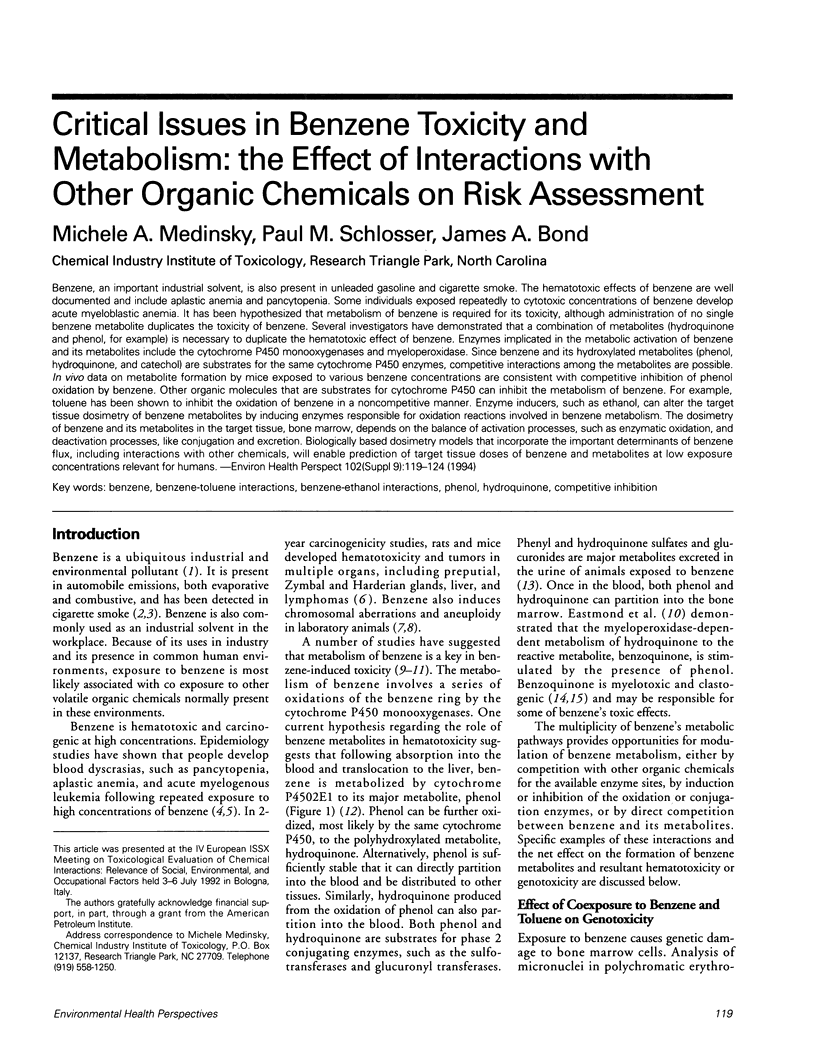
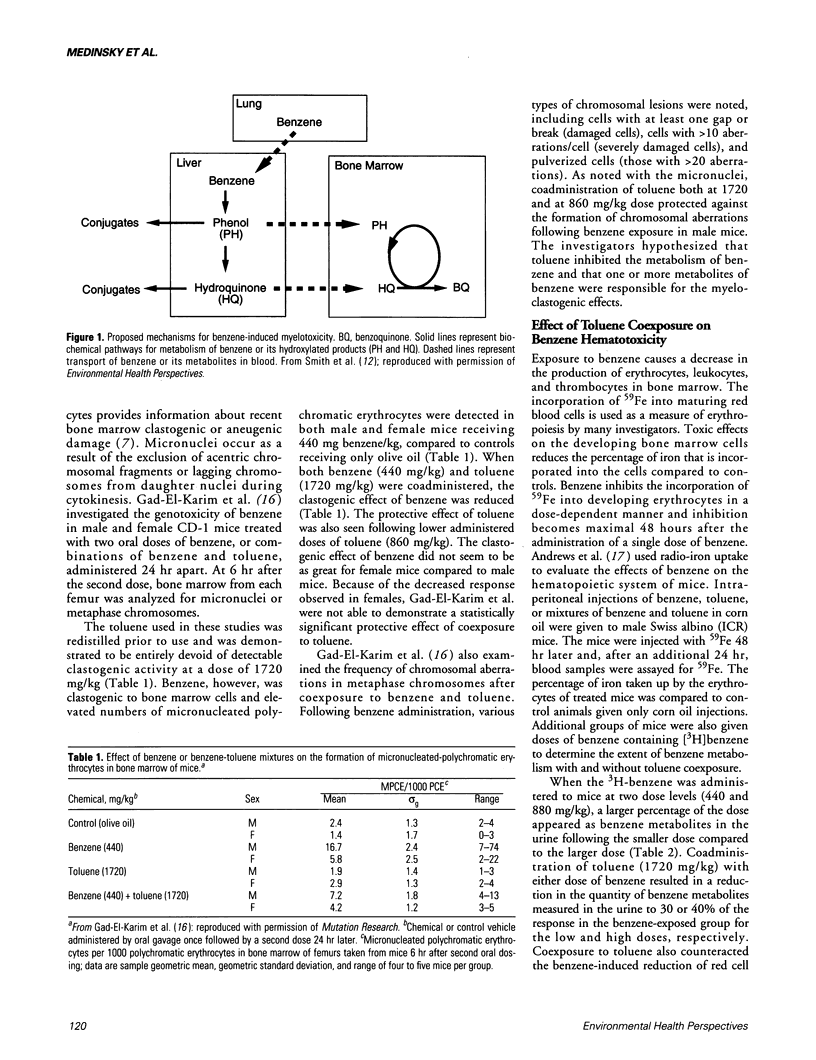
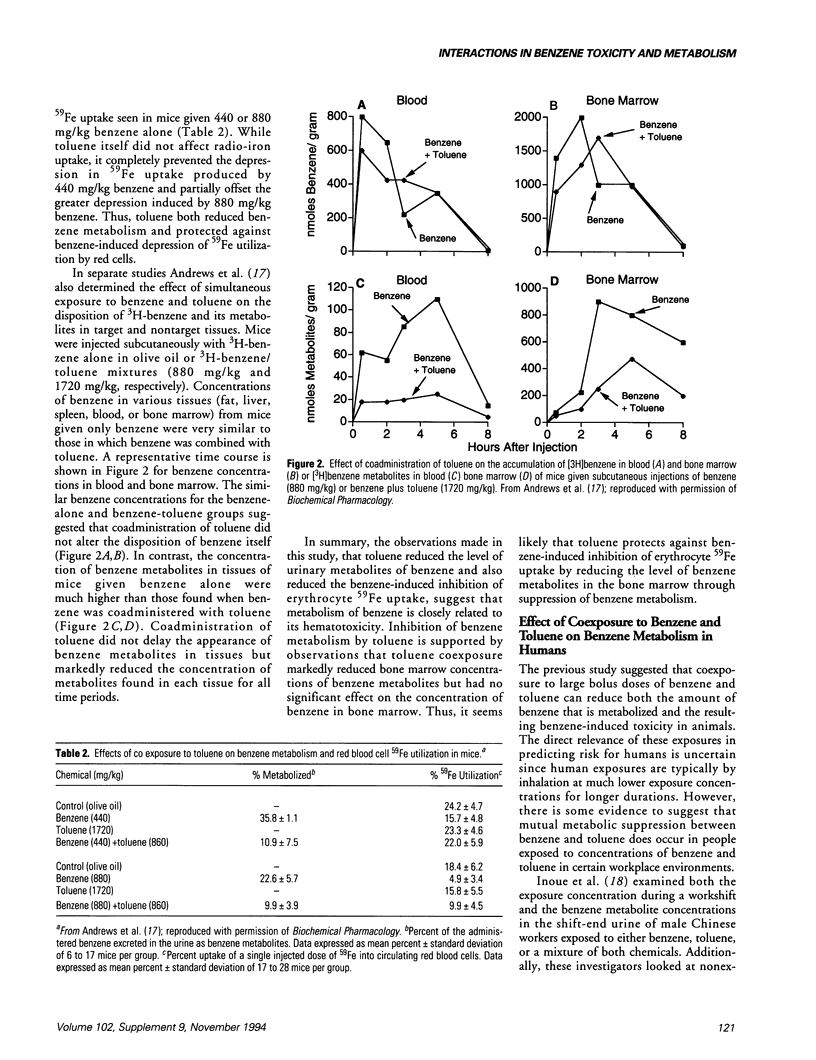
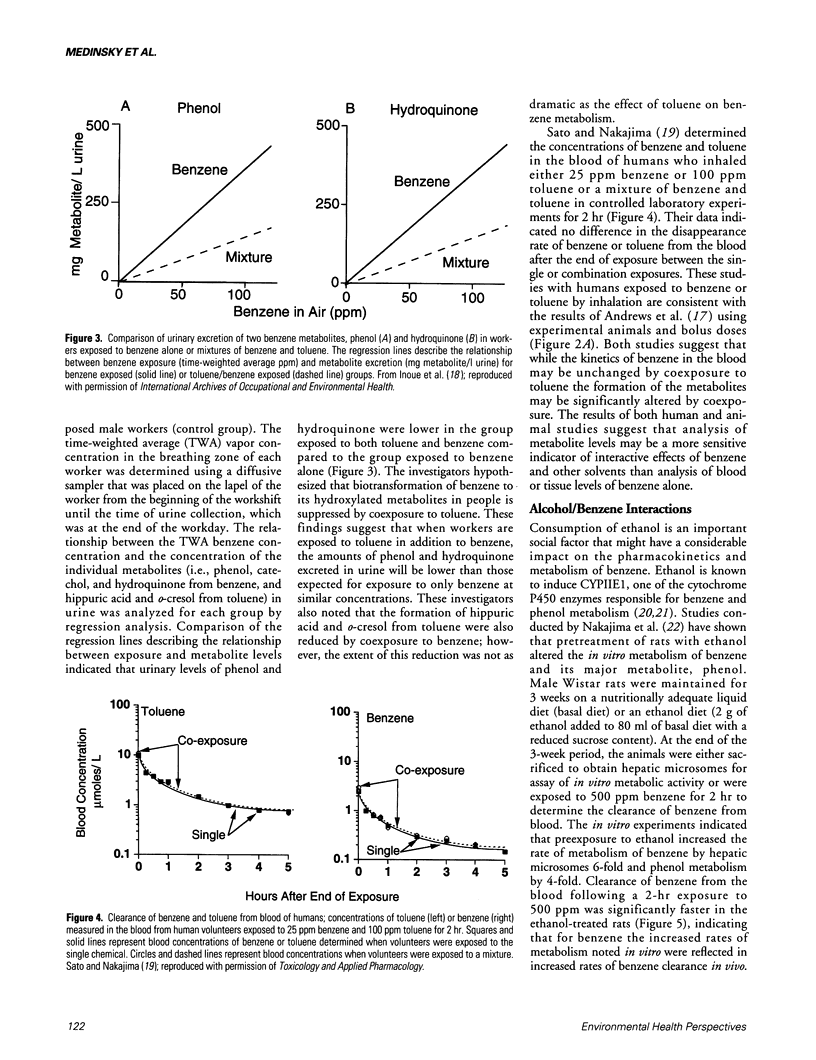
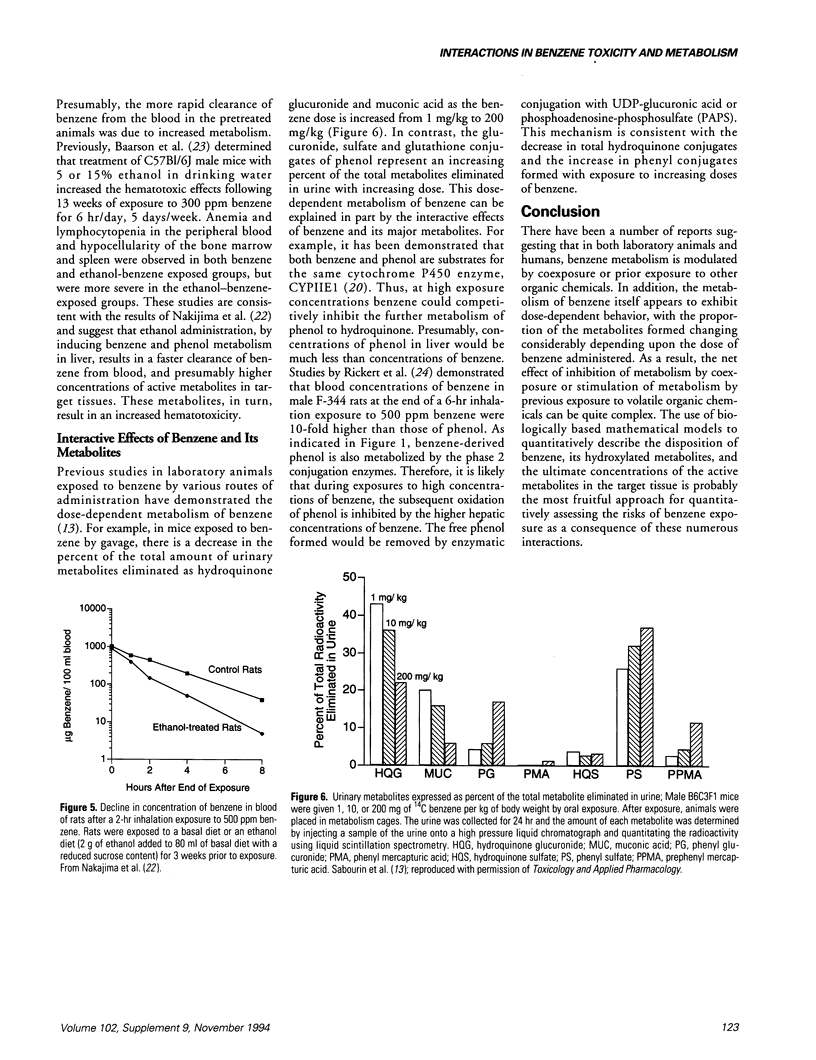
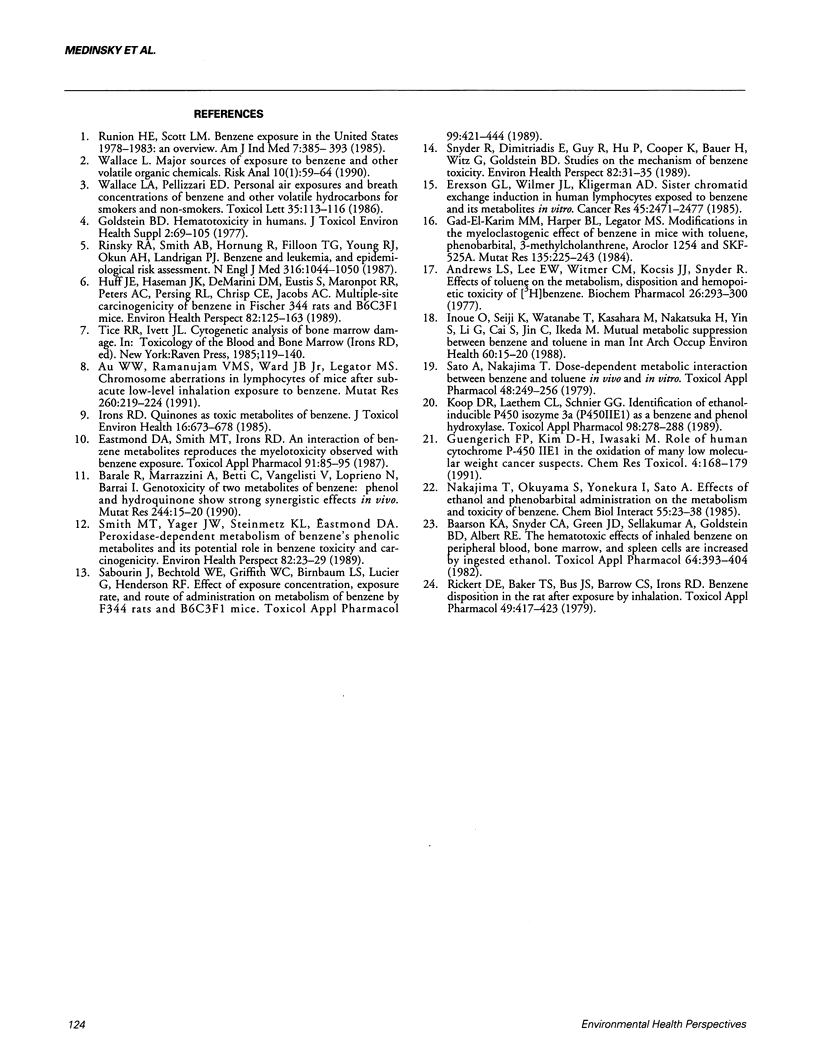
Selected References
These references are in PubMed. This may not be the complete list of references from this article.
- Andrews L. S., Lee E. W., Witmer C. M., Kocsis J. J., Snyder R. Effects of toluene on the metabolism, disposition and hemopoietic toxicity of [3H]benzene. Biochem Pharmacol. 1977 Feb 15;26(4):293–300. doi: 10.1016/0006-2952(77)90180-0. [DOI] [PubMed] [Google Scholar]
- Au W. W., Ramanujam V. M., Ward J. B., Jr, Legator M. S. Chromosome aberrations in lymphocytes of mice after sub-acute low-level inhalation exposure to benzene. Mutat Res. 1991 Jun;260(2):219–224. doi: 10.1016/0165-1218(91)90011-a. [DOI] [PubMed] [Google Scholar]
- Baarson K. A., Snyder C. A., Green J. D., Sellakumar A., Goldstein B. D., Albert R. E. The hematotoxic effects of inhaled benzene on peripheral blood, bone marrow, and spleen cells are increased by ingested ethanol. Toxicol Appl Pharmacol. 1982 Jul;64(3):393–404. doi: 10.1016/0041-008x(82)90235-6. [DOI] [PubMed] [Google Scholar]
- Barale R., Marrazzini A., Betti C., Vangelisti V., Loprieno N., Barrai I. Genotoxicity of two metabolites of benzene: phenol and hydroquinone show strong synergistic effects in vivo. Mutat Res. 1990 May;244(1):15–20. doi: 10.1016/0165-7992(90)90101-o. [DOI] [PubMed] [Google Scholar]
- Eastmond D. A., Smith M. T., Irons R. D. An interaction of benzene metabolites reproduces the myelotoxicity observed with benzene exposure. Toxicol Appl Pharmacol. 1987 Oct;91(1):85–95. doi: 10.1016/0041-008x(87)90196-7. [DOI] [PubMed] [Google Scholar]
- Erexson G. L., Wilmer J. L., Kligerman A. D. Sister chromatid exchange induction in human lymphocytes exposed to benzene and its metabolites in vitro. Cancer Res. 1985 Jun;45(6):2471–2477. [PubMed] [Google Scholar]
- Gad-El-Karim M. M., Harper B. L., Legator M. S. Modifications in the myeloclastogenic effect of benzene in mice with toluene, phenobarbital, 3-methylcholanthrene, Aroclor 1254 and SKF-525A. Mutat Res. 1984 Mar;135(3):225–243. doi: 10.1016/0165-1218(84)90126-5. [DOI] [PubMed] [Google Scholar]
- Goldstein B. D. Benzene toxicity: a critical evaluation: hematotoxicity in humans. J Toxicol Environ Health Suppl. 1977;2:69–105. [PubMed] [Google Scholar]
- Guengerich F. P., Kim D. H., Iwasaki M. Role of human cytochrome P-450 IIE1 in the oxidation of many low molecular weight cancer suspects. Chem Res Toxicol. 1991 Mar-Apr;4(2):168–179. doi: 10.1021/tx00020a008. [DOI] [PubMed] [Google Scholar]
- Huff J. E., Haseman J. K., DeMarini D. M., Eustis S., Maronpot R. R., Peters A. C., Persing R. L., Chrisp C. E., Jacobs A. C. Multiple-site carcinogenicity of benzene in Fischer 344 rats and B6C3F1 mice. Environ Health Perspect. 1989 Jul;82:125–163. doi: 10.1289/ehp.8982125. [DOI] [PMC free article] [PubMed] [Google Scholar]
- Inoue O., Seiji K., Watanabe T., Kasahara M., Nakatsuka H., Yin S. N., Li G. L., Cai S. X., Jin C., Ikeda M. Mutual metabolic suppression between benzene and toluene in man. Int Arch Occup Environ Health. 1988;60(1):15–20. doi: 10.1007/BF00409373. [DOI] [PubMed] [Google Scholar]
- Irons R. D. Quinones as toxic metabolites of benzene. J Toxicol Environ Health. 1985;16(5):673–678. doi: 10.1080/15287398509530777. [DOI] [PubMed] [Google Scholar]
- Koop D. R., Laethem C. L., Schnier G. G. Identification of ethanol-inducible P450 isozyme 3a (P450IIE1) as a benzene and phenol hydroxylase. Toxicol Appl Pharmacol. 1989 Apr;98(2):278–288. doi: 10.1016/0041-008x(89)90233-0. [DOI] [PubMed] [Google Scholar]
- Nakajima T., Okuyama S., Yonekura I., Sato A. Effects of ethanol and phenobarbital administration on the metabolism and toxicity of benzene. Chem Biol Interact. 1985 Oct;55(1-2):23–38. doi: 10.1016/s0009-2797(85)80118-6. [DOI] [PubMed] [Google Scholar]
- Rickert D. E., Baker T. S., Bus J. S., Barrow C. S., Irons R. D. Benzene disposition in the rat after exposure by inhalation. Toxicol Appl Pharmacol. 1979 Jul;49(3):417–423. doi: 10.1016/0041-008x(79)90441-1. [DOI] [PubMed] [Google Scholar]
- Rinsky R. A., Smith A. B., Hornung R., Filloon T. G., Young R. J., Okun A. H., Landrigan P. J. Benzene and leukemia. An epidemiologic risk assessment. N Engl J Med. 1987 Apr 23;316(17):1044–1050. doi: 10.1056/NEJM198704233161702. [DOI] [PubMed] [Google Scholar]
- Runion H. E., Scott L. M. Benzene exposure in the United States 1978-1983: an overview. Am J Ind Med. 1985;7(5-6):385–393. doi: 10.1002/ajim.4700070505. [DOI] [PubMed] [Google Scholar]
- Sabourin P. J., Bechtold W. E., Griffith W. C., Birnbaum L. S., Lucier G., Henderson R. F. Effect of exposure concentration, exposure rate, and route of administration on metabolism of benzene by F344 rats and B6C3F1 mice. Toxicol Appl Pharmacol. 1989 Jul;99(3):421–444. doi: 10.1016/0041-008x(89)90151-8. [DOI] [PubMed] [Google Scholar]
- Sato A., Nakajima T. Dose-dependent metabolic interaction between benzene and toluene in vivo and in vitro. Toxicol Appl Pharmacol. 1979 Apr;48(2):249–256. doi: 10.1016/0041-008x(79)90030-9. [DOI] [PubMed] [Google Scholar]
- Smith M. T., Yager J. W., Steinmetz K. L., Eastmond D. A. Peroxidase-dependent metabolism of benzene's phenolic metabolites and its potential role in benzene toxicity and carcinogenicity. Environ Health Perspect. 1989 Jul;82:23–29. doi: 10.1289/ehp.898223. [DOI] [PMC free article] [PubMed] [Google Scholar]
- Snyder R., Dimitriadis E., Guy R., Hu P., Cooper K., Bauer H., Witz G., Goldstein B. D. Studies on the mechanism of benzene toxicity. Environ Health Perspect. 1989 Jul;82:31–35. doi: 10.1289/ehp.898231. [DOI] [PMC free article] [PubMed] [Google Scholar]
- Wallace L. A., Pellizzari E. D. Personal air exposures and breath concentrations of benzene and other volatile hydrocarbons for smokers and nonsmokers. Toxicol Lett. 1987 Jan;35(1):113–116. doi: 10.1016/0378-4274(87)90094-4. [DOI] [PubMed] [Google Scholar]


